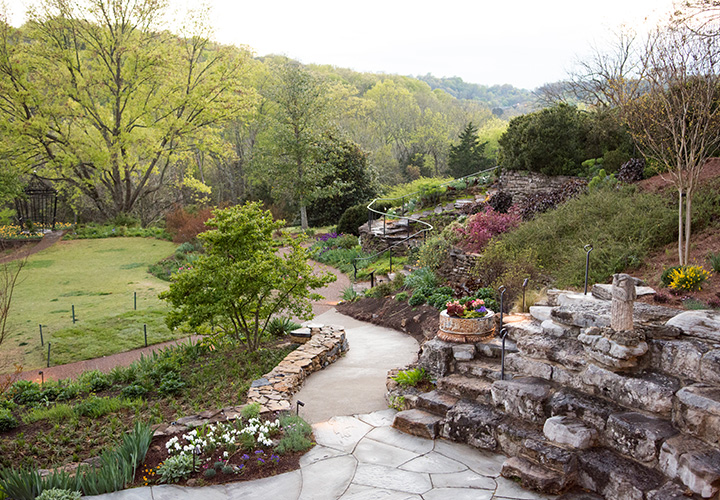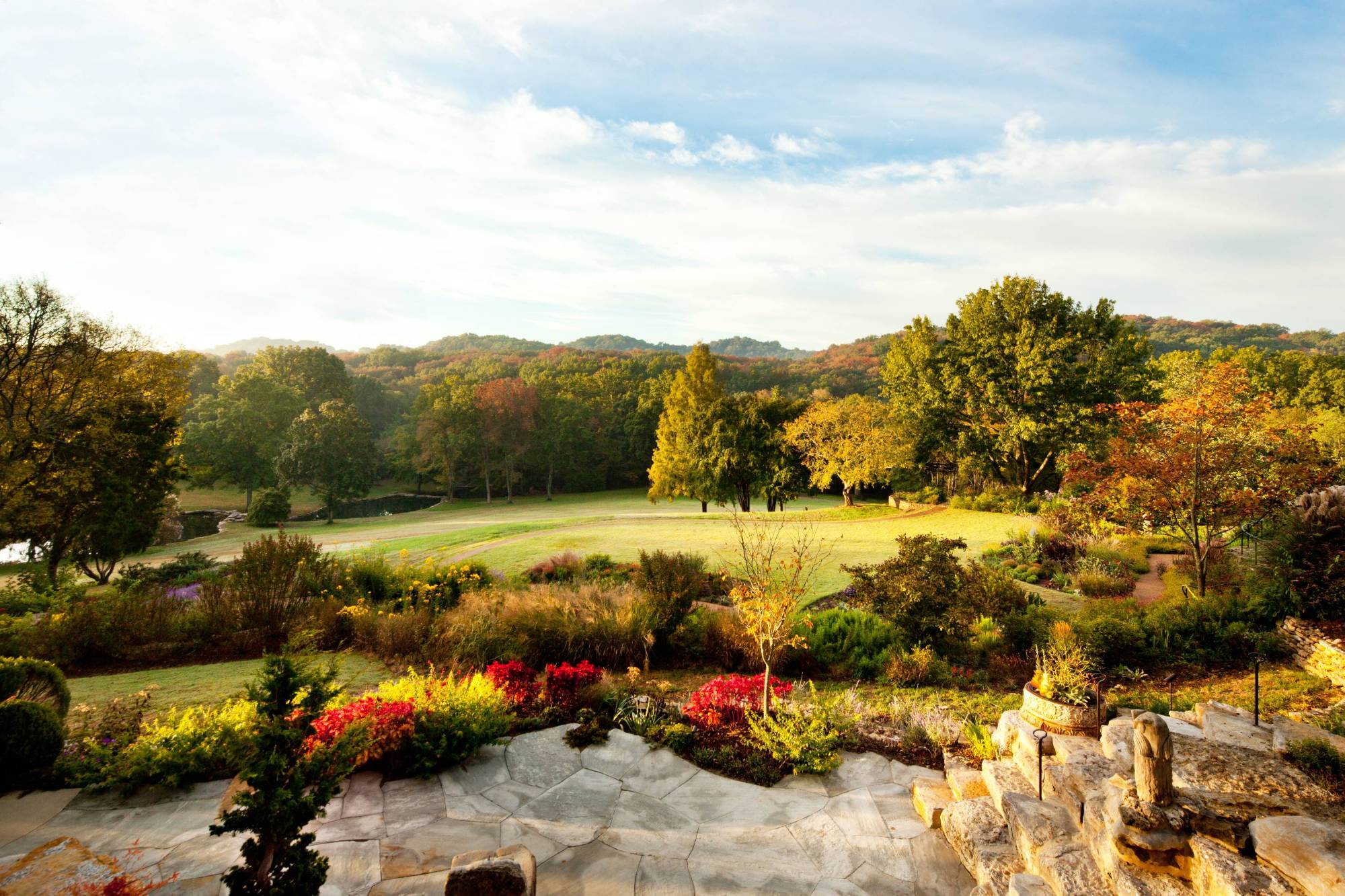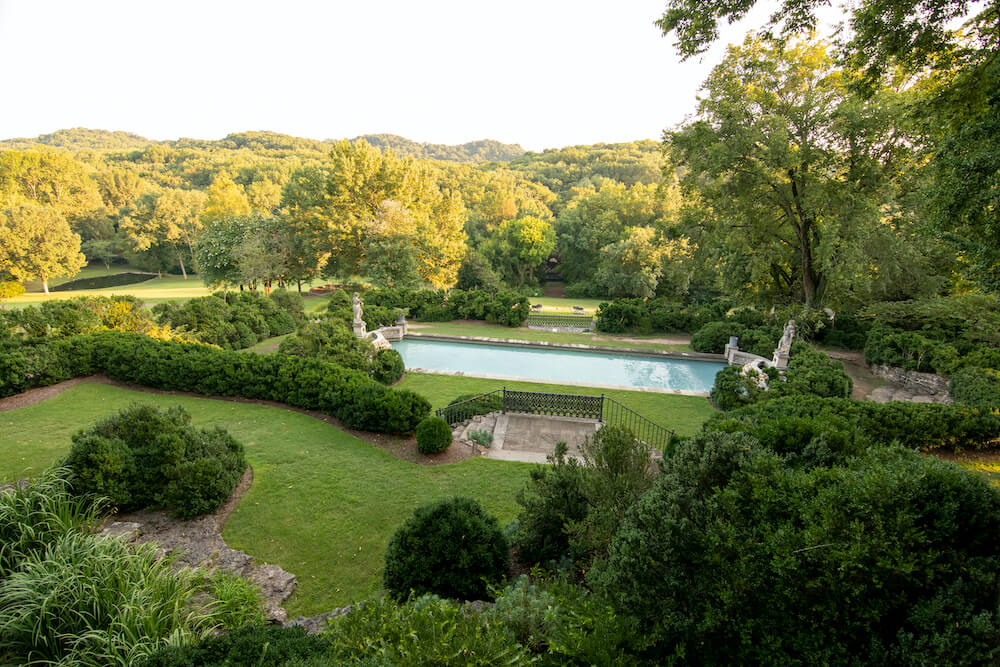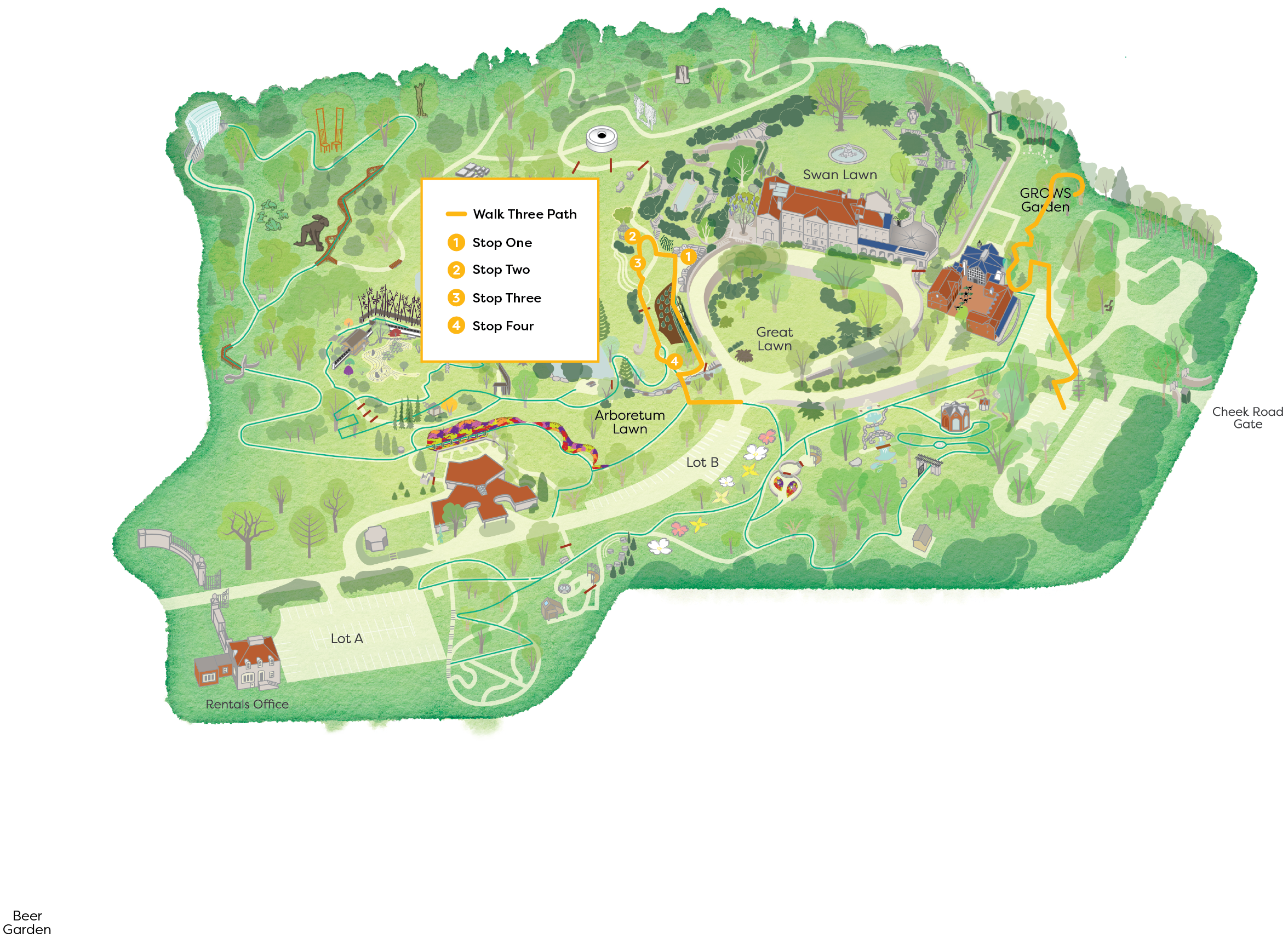About the Gardens
The third phase originates in the Sigourney Cheek Literary Garden and guides you into a mindset of openness as you walk through the Wills Perennial and Martin Boxwood Gardens. These gardens, found to the left of the Cheek Mansion, offer you a more secluded environment for approaching unwieldy and predominant emotions or thoughts through a method known as “RAIN” (recognize, allow, investigate, and non-identify).

The Sigourney Cheek Literary Garden
Created to pay tribute to the late Sigourney Cheek and to serve as a place to seek solace and to inspire literacy by promoting reading, writing, and reflective thought. Sigourney loved Nashville deeply and supported many local not-for-profit institutions, including Cheekwood. She was a life-long learner, a community leader, inspirational spirit, and avid gardener whose home garden is listed as “an Important American Garden” at the Smithsonian Institute. From this space, visitors of the garden experience a gorgeous view of the Tennessee hills

Wills Perennial Garden
Below the formal gardens of the mansion, overlooking the mustard meadow and the ponds of is the Wills Perennial Garden. Dedicated to iris breeder and author, Jesse Wills, the garden displays both new and traditional perennials and many bearded irises. A steep limestone wall provides both habitat and background for this colorful, full-sun garden. The Wills Perennial Garden reaches its peak in the summer when the succession of color culminates with asters, salvias, perennial sunflowers, rudbeckias, and ornamental grasses.

The Hayes Fern Collection
Ferns can be found around every garden corner at Cheekwood. Widely known to be shade tolerant groundcovers, a few varieties, such as Japanese Holly Fern (Cyrtomium falcatum), are evergreen during the rather mild Tennessee winter. Cinnamon fern (Osmunda cinnamomea) unfurls around Cheekwood’s ponds and streams beginning in March, its fertile fronds decorated with golden brown fruit dots. Autumn fern (Dryopteris erythrosora) another evergreen species, brightens darker sections of the property with its corals and chartreuse tones. Cheekwood’s fern collection is represented with thirty-eight different species and over four thousand individuals, a small portion of which are on display in the Hayes Fern Collection.

About Walk Three
Walk Three is more challenging in that it pushes us to slow our judgement and open ourselves up to the root of a sensation, then evaluate, and finally decide how to respond – strengthening our emotional intelligence.1 This is best suited when you need to confront deep or reactive emotions.
Remember to allow yourself at least 10 minutes at the beginning of each walk to become present. One way to do this is by practicing the steps outlined in Walk One and Two. Consider the sights, sounds, textures, and scents around you. Be curious by slowing down, wondering, speaking less, and seeking answers.
You can reach the Sigourney Cheek Literary Garden by continuing past Botanic Hall, through the sidewalk into the Color Garden and straight across Arboretum Lawn. You will eventually find a circular overlook that leads to the Literary Garden. Follow the path to your right and you will find the Literary Garden tucked below the road to the Mansion.
Each stop on Walk Three is marked by a yellow circle along the path.
Before you begin:
Stand still and take a deep breath. In and out.
Take note of how your body is feeling.
As you walk:
Bring attention to the movements and sensations in your body. Notice how your hips and shoulders move, your steps firm on the ground, how your chest rises and falls with each breath, gently and assuredly.
Prompts
Each stop on Walk One is marked by a yellow circle on the path.
Stop One: Recognize
The Sigourney Cheek Literary Garden was designed for contemplation, growth, and learning. This vantage point provides relative solitude and a wide lens to overlook one of the most open areas of the gardens. Here, take a moment to recognize what emotions you might be feeling, positive and negative. Make note of them. Some emotions are hard to put names to. Be careful not to slip into self-criticism or judgement. When you’re ready, begin walking and continue your journey.
Stop Two can be found by following the path down the hill towards the right. Overlook the meadowed hill by settling in the gazebo.
Stop Two: Allow
At the next stop in the Wills Perennial Garden gazebo, we encourage you to sit among the wildflowers long enough to let the garden residents (chipmunks, field mice, birds and, at the right time of day, fawns) settle into their homes. Now that you’ve recognized the emotions you are feeling, allow yourself to feel them for exactly what they are. You might find that the stress of not knowing has melted away and now you can think a little more clearly. When you’re ready, begin walking and continue your journey.
Step out of the Wills Perennial Garden Gazebo an onto the grassy expanse overlooking the meadow. Pause here for Stop Three.
Stop Three: Investigate
Once you reach the Martin Boxwood Garden, pause, and look behind you. In the clarity of recognition and allowance, and with an attitude of curiousness, start asking yourself questions about your current mental state. How did this begin? Have you felt this way before? What do you need to do? Let yourself explore the elements of these emotions that go beyond the main negative feeling and take note of these things. This isn’t necessarily a clinical dissection of your mind, just a widening of your perspective on the emotion you’re feeling. When you’re ready, begin walking and continue your journey.
Stop Four can be found by following the path toward Arboretum Lawn. The fernery is tucked between the walkways.
Stop Four: Non-Identify
Examine the collection of ferns tucked into this shady corner. See how each, though regarded as the same species, vary so widely? There are even differences between each frond on the same plant. Recognize yourself as a whole person. Notice that, just as the sights, sounds, textures, and scents change, so will you, your emotions, situations, and relationships. We have only a loose grip on these things in our story. Use this space to grow in understanding of what underlies the fear, anger, and sadness in life.
Take three deep breaths. Each one deeper than the last.
Sit in gratitude, forgiveness, and assurance.
Think on these things as you reach the end of Walk Three.
“It is when we act freely, for the sake of the action itself, rather than for ulterior motives, that we learn to become more than what we were. When we choose a goal and invest ourselves in it to the limits of concentration, whatever we do will be enjoyable. And once we have tasted this joy, we will redouble our efforts to taste it again. This is the way the self grows.”
-Mihaly Csikszentmihalyi, Flow: The Psychology of Optimal Experience
OPENNESS REFERENCES: Include as small print at bottom of page that reference falls on
Nawal G. Alghamdi, Muhammad Aslam, Khushnoor Khan,
